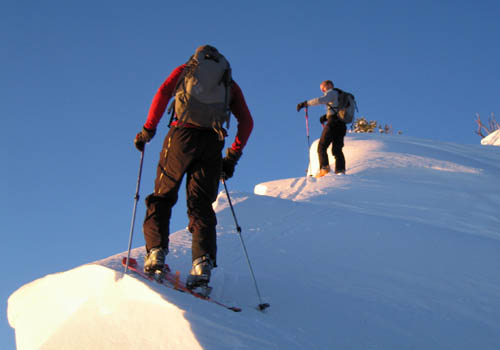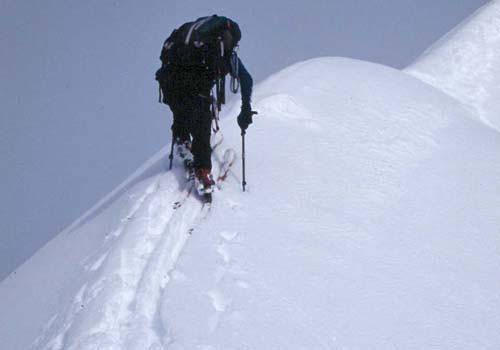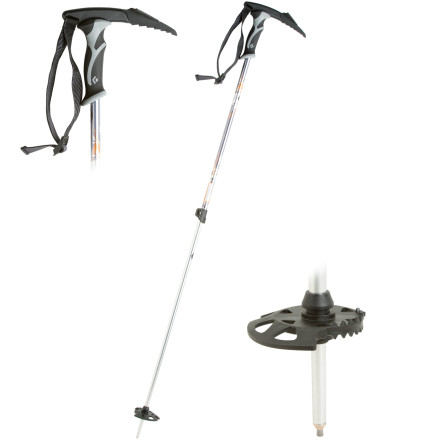Steep Skinning – Gear Adjustment
Heel lifters are absolutely essential and should be turned to their highest setting. Don’t be bashful. Certified guides dislike heel lifters for their clients as they are too tippy, but once you get the feel of them, there is no going back. It’s kind of like walking around on a roof with high-heels – it may not seem like a good idea, but it keeps your foot flat so you can use your thigh muscles instead of your calves.
Shorten your poles down so you can get on top of them instead of hanging off of them. Pushing on them instead of pulling allows you to use your arms, chest and back instead of just your arms. It is the difference between doing push-ups and pull-ups. I can do little cheater push-ups all day long but am cooked after about ten pull-ups. If you have asymmetrical baskets (and you should), rotate them with the short side forward so they don’t lever out.
Get some good nylon skins. Nylons are known for their sticky climbing abilities and that’s what we are talkin’ about here. Good glue and a tip & tail kit are also important for steep skinning as you put a lot more sheering force on your skins than when you are just scooting along on the flats.
Undo your top boot buckles so you have maximum ankle flex. I usually keep my forefoot buckle fairly tight (as tight as I’d have it for skiing), the ankle buckle semi tight and totally undo the top buckle. I don’t use the Velcro powerstrap, but if I did, I’d loosen that all the way as well. Of course, make sure your boots are in tour, not ski, mode. Like friction climbing, steep skinning requires a subtle feel and you want control without restriction from your boots.
________________________________
Help support StraightChuter.com and get on top of a Black Diamond Whippet Self Arrest Pole on sale now at Backcountry.com. Click on the photo below…
Category: 05 Uphill












Andrew, what are your thoughts on cutting skins wall to wall vs. edge free? BD lit says to leave the edges open but over time I’ve come to prefer the full coverage. If it’s steep and icey enough to require the bight of metal edges, booting or crampons are preferrable to skins anyway. The skin edges get blitzed anyway so thats no reason to cut them edge-narrow. Thoughts?
Hi OMR – I wrote something up on that earlier which can be found here:
http://straightchuter.com/2008/12/skin-set-up-part-one/
I prefer to trim the skins back by about 3/16″ of an inch from the edges as I like/love having the sharp edge when I need it. The downside is that it takes longer to trim them, but it looks like G3 has a cool little tool which will help with this.
I like having edges exposed.
Not familiar with the G3 tool, but a good old-fashioned utility knife works just fine. Better than the Black Diamond letter opener to be sure.
I also think fatter skis make balancing on full heel pegs easier. Since most of my skiing is dawn patrol, and we’re trying to get in as much vert as fast as we can, I’m on full pegs at least 80% of the time.
Andrew, although I agree with you that there are times when a steep skintrack is just what is needed, this meadow skipper has suffered on a Wasatch skintrack now and again. Most problems seem to come when the track reaches an angle such that I can no longer properly weight the heel and end up having to pressure the toe in order to maintain balance. Out of curiosity (and in an attempt to add some legitimacy to my whining), I took a measurement of heel-height (w/ high post) and pivot-point-to-lift-contact-point-length, i.e. the two sides of a right triangle. Applying the formula arctan(height/length) nets me a lift angle of 13.3 degrees, which doesn’t sound too impressive. I’m hurt by a combo of BD O2 and size 13 boots, but I’m curious what your setup measures out at? Guess I should make up a really high pair of the oldtime pvc heels for those special moments, or maybe I should just convert to Dynafit? :-)
Hi John – That’s a great question and although I don’t know the answer right offhand, I’ll check it out and report back.
I know when I was skiing Fritschi bindings, I could barely squeeze into a “small” size, which I preferred as it had less bar to break, but also meant that the heel riser was steeper (shorter leg of the triangle).